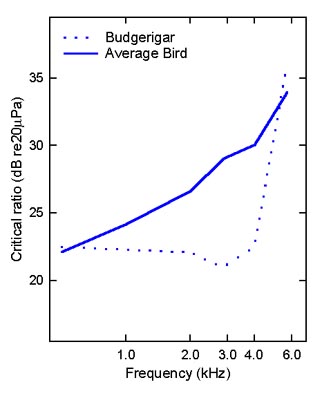The General Effects of Noise on Hearing in Birds

|
Common experience tells us that background
noise can interfere with hearing and speech communication in humans. The
same is generally true of animals. A great deal has been learned over
the last several decades about the effect of noise on hearing thresholds
in both humans and animals including birds. One useful measure, the
critical ratio (the ratio of tone intensity to noise intensity expressed
in decibels), tells us how loud a pure tone must be to be detected
against a background of broadband, white noise. The critical ratio is
the level of the pure tone at threshold (in dB) minus the spectrum level
(dB per Hz) of the noise.
Critical ratios have been measured in the laboratory for a number of species of birds including: budgerigars, canaries, starlings, song sparrows, swamp sparrows, red-wing blackbirds, cowbirds, great tits, cockatiels, and barn owls. In general, the effect of white noise on hearing thresholds in birds (as well as in humans) doubles with every doubling of frequency. In other words, the critical ratio at 2.0 kHz is 3 dB higher than the critical ratio at 1.0 kHz. However, some birds, such as budgerigars, show a remarkably different masking pattern. The figure at left shows that for the average bird (solid line), critical ratios increase from about 22 dB at 500 Hz to about 34 dB at 8.0 kHz (or, in other words, about 3 dB/octave). Critical ratios in the budgerigar, by contrast, are fairly flat between 500 Hz and 3.0 kHz and then increase dramatically up to 8.0 kHz. Among other things, these results suggest that budgerigars hear better in noise than other birds at frequencies between 2-4 kHz. Importantly, these laboratory studies of masking by noise can also be used to make predictions about how environmental or anthropogenic (human-made) noise affects the abilities of birds to hear each other in the real world. These data will help environmental scientists decide whether traffic, airport, industrial, or military noise produced by our modern society might have a harmful effect on the survival of endangered species of birds. |
